Brick Lane is story of Nazneen’s life, a girl is turned upside down at the tender age of seventeen,. Forced intoan arranged marriage to an older man; she exchanges her Bangladeshi village home for a block of flats in London’s East End. In this new world, pining for her home and her sister, she struggles to make sense of her existence – and to do her duty to her husband. A man of inflated ideas (and stomach), he sorely tests her compliance. Told from birth that she must not fight her fate, Nazneen submits, devoting her life to raising her family and slapping down her demons of discontent. Until the day that Karim, a hot-headed local man, bursts into her life.
Against a background of escalating racial tension, they embark on an affair that finally forces Nazneen to take control of her life. Set in multicultural Britain, Brick Lane is a truly contemporary story of love, cultural difference, and ultimately, the strength of the human spirit.
Brick Lane’s director, Sarah Gavron began her career in documentaries and is a graduate of the NFTS. In 2003 Gavron directed her first full length drama, the Dennis Potter Award winning This Little Life for BBC TV. The film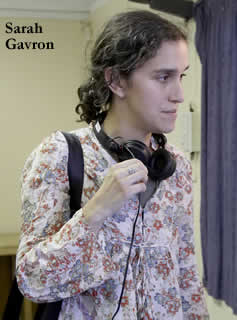 also won Gavron two BAFTAs for Best Single Drama and Best New Director, the RTS and WIFTV Award for Best Newcomer and she was selected as one of Variety’s ten directors to watch at the Sundance International Film Festival. Gavron has made many short films which have screened internationally and won major awards.
also won Gavron two BAFTAs for Best Single Drama and Best New Director, the RTS and WIFTV Award for Best Newcomer and she was selected as one of Variety’s ten directors to watch at the Sundance International Film Festival. Gavron has made many short films which have screened internationally and won major awards.
Bijan Tehrani: When did you first read “Brick Lane”, and how did you decide to make it into a film?
Sarah Gavron: Well, I actually read it when it came out, and I didn’t think about making it into a film. I read it when everybody was obsessed with it in the UK; it was a huge best seller. I remember traveling on the London underground seeing four or five copies of it being read by different people of different ages, which shows its appeal across cultures and generations. I was very taken by the book then, but it was only in 2004 when Film 4, who was talking with me about doing a film, had optioned the rights to Monica Ali’s “Brick Lane”. I thought it would be very daunting and challenging, but irresistible at the same time;daunting because it is this well-loved novel that is 500 pages, and distilling that was going to be a challenge, as was satisfying its fans. But I thought it was daunting also because I was an outsider to that community. Although I did grow up in London, and grew up around immigrant communities, I didn’t have an insider view of the Bangladeshi community in East London.
BT: It is a very difficult book to make into a film. Film directors can fall into the trap of translating the words of the book into images, often without bringing the sense of the book into the film. This is a wonderful film that actually does bring the sense of the book onto the screen.
SG: I am pleased to hear that, because in a way that was our aim. We talked about capturing the spirit of the novel, its essence, but not to be trapped in staying to the letter of it. We made a lot of tough choices and went through many drafts of the script. There were so many ways to approach this novel. You could’ve told the parallel story of two sisters. You could’ve told the arc of Nazneen’s entire life as an anti-thesis and synthesis. But we decided to focus on the year of 2001, see it through the prism of that year, which is really the year that she changes. We decided 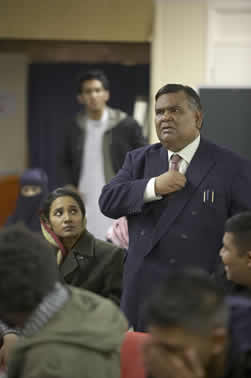 to use the Bangladesh of her childhood to haunt her waking dreams, and show how she was living partly in her imagination for part of the story, and pining for home. It is only when she becomes engaged with the world around her that those images of Bangladesh start to recede.
to use the Bangladesh of her childhood to haunt her waking dreams, and show how she was living partly in her imagination for part of the story, and pining for home. It is only when she becomes engaged with the world around her that those images of Bangladesh start to recede.
BT: You mentioned that you were an outsider to that community, which can sometimes feel like being in a different country. How did you come to know these people so well?
SG: In some ways as a director in that situation there can be an advantage. It is like you are standing in the doorway looking in, and your job is to pull out the universal story and the emotional story. But obviously the particular is what makes the story live. Thankfully filmmaking is collaboration, and I worked very closely with the Bangladeshi community, and people came on board as cast and crew. I took on an associate director in England and India. The associate director in England was a Bangladeshi East London filmmaker. So he was sort of taking care of all the cultural specifications. Meanwhile we went into people’s homes and talked to many people in the community. There is a precedent in filmmaking for being an outsider. I am intrigued by directors like Ang Lee who came and made “Sense and Sensibility”, and Shekhar Kapur making “Elizabeth”. But obviously you are very dependent on that collaboration, and I couldn’t have made this film without the input of the Bangladeshi community.
BT: The visual style of this film is very interesting. How did you come up with it and the differentiation between the images of the past, in Bangladesh, and the images in the present?
SG: Yes, we wanted to create that contrast between the two different worlds, and make Bangladesh more visually bright. The challenge of a novel is that it is interior, and it captures in its prose the internal worlds of the characters. So how then do you translate that onto the screen? The overall idea for the visual language of the film was to see the world through Nazneen’s eyes. We wanted to make the mise-en-scene about Nazneen’s emotional state, from the music to the colors to the sound and set design. So when she is looking back on Bangladesh – Bangladesh is a country that in reality is beset by natural disasters and political instability, but is also a very beautiful country and culturally very rich – her memory of it is a sort of half truth. Home is obviously a very powerful magnet that people remember in a very particular way when they leave the country, and we wanted to convey that. But later on we wanted to subvert that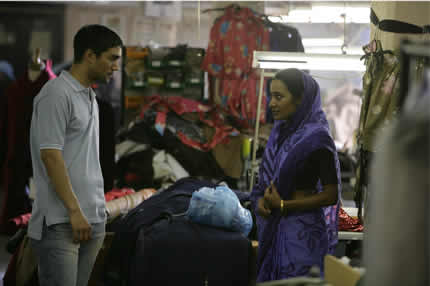 when Chanu reveals to Nazneen the harsh reality of her sister’s life. We also contrasted it with the claustrophobia of her life in England. There is a claustrophobic feel to the interior of the flat, which has some touches of her home, in the fabrics and colors, but it is essentially British and Western.
when Chanu reveals to Nazneen the harsh reality of her sister’s life. We also contrasted it with the claustrophobia of her life in England. There is a claustrophobic feel to the interior of the flat, which has some touches of her home, in the fabrics and colors, but it is essentially British and Western.
BT: The characters don’t stay one dimension. They move and change, and find new things about themselves. Especially Chanu, he changes so much.
SG: Yes. I have always thought that about Chanu. What was so unique about the novel is that it dealt not in stereotypes, but it created complex and nuanced people that we could all connect with. They are not the extremes we are used to seeing now. The gaze is so much on the Muslim world, and these characters are not those extremes. Chanu does not beat his wife, he is didactic and foolish at times, but he is also funny and wise and gains stature and depth as the film goes on. Perhaps he doesn’t change so much, but that Nazneen changes as she sees different aspects of him, or we reveal different aspects of him, so we change our view of him through the film. That remained important–that he is multi-dimensional. So we see this sympathetic man who is generous enough to finally leave his wife and allow her to be independent. Karim’s changes are very reflective of the time we live in and the way that 9-11 affected the community, particularly the younger generation. The split in the generations is summed up in that meeting scene, when Chanu declares that Bangladesh was founded by Muslims fighting Muslims. Chanu is an opposing voice trying to remind the younger generation of their cultural roots because post 9-11 that younger generation started to identify with that global Muslim community, which is the journey Karim is on. He is reforming his identity and searching for home post 9-11. Nazneen has a very dramatic change, pining for home and lost in the world of her past. Then, through the catalyst of Karim, she engages in the world around her. She 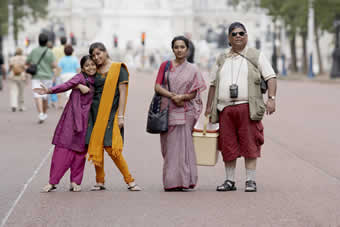 finally goes beyond the both men in some ways and does find home and who she is, and her place in a world that has for so long been alien.
finally goes beyond the both men in some ways and does find home and who she is, and her place in a world that has for so long been alien.
BT: This brings me to the question of casting, which is so marvelous. How did you go about casting the film?
SG: Well it was really a nightmare in some ways. You normally go to a casting director and at least can rely on a number of lists of people, and go through the familiar names to check to see who is available. But we couldn’t do that with this film, because no one had cast a film quite like it. Each role demanded a totally different approach. When we were dealing with the British Bangladeshi characters of Karim and the children, there is no tradition of acting in those communities, so you can’t find them in the stage schools and the acting schools. So we did open auditions in the community, we put out fliers and went into schools, and met children who had never done acting before, and talked to their parents about whether they would be comfortable with it. That was a long and involved process. For the adult parts – Chanu and Nazneen are very demanding roles – we went on this worldwide search. We met talent in the UK and all over south Asia. Tannishtha, funnily enough, was the first person we met in India. She is Bengali, her grandparents came to Bangladesh before partition, so she spoke the language and had the right feel. But also she is a very instinctive and intelligent actress, and understood how to express herself subtly through body language and with very little else. She was a real find for us; and we built our cast around her. We were three weeks before shooting and we still hadn’t found a Chanu. Suddenly someone mentioned him – because Satish Kaushik was a Bollywood director, so he wasn’t on anyone’s radar – but I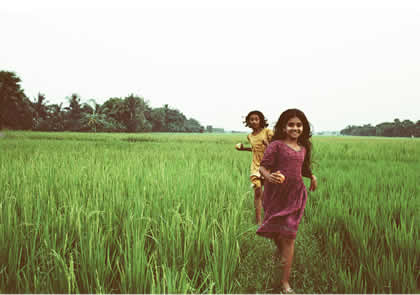 google’d him and thought he looked perfect, but didn’t know if he could act. I spoke to Tannishtha and she talked about how she knew him from his theater work, and that he played Willie Loman in “Death of a Salesman” in an Indian production. I always thought that Arthur Miller’s character of Willie Loman is very connected to Chanu, in the canvass of those characters of dreamers and idealists who finally lose hope. So we flew to Dehli and met Satish, who really felt that he had built up his career to play this part. So that was really a great discovery to find Satish.
google’d him and thought he looked perfect, but didn’t know if he could act. I spoke to Tannishtha and she talked about how she knew him from his theater work, and that he played Willie Loman in “Death of a Salesman” in an Indian production. I always thought that Arthur Miller’s character of Willie Loman is very connected to Chanu, in the canvass of those characters of dreamers and idealists who finally lose hope. So we flew to Dehli and met Satish, who really felt that he had built up his career to play this part. So that was really a great discovery to find Satish.
BT: Considering all the tension in the Muslim community in England, how is the film being received there?
SG: Did you hear that there were some protests over some of the filming?
BT: No I didn’t hear that actually.
SG: Yea, it was an interesting journey. We went into the community, as I had said, and we got a lot of people who were enthusiastic and welcoming. I was very clear that it wasn’t a representation, and that it was just one story, and a fictional story, and let’s hope many more stories come out. So we had all of this support. And then when we were three weeks into shooting, and we had shot the interiors of the flat and the estate in East London, and we were about to shoot on Brick Lane itself. Really in the story, the title of Brick Lane is symbolic, because that one street has been a sanctuary for successive waves of immigrants for hundreds of years. There is a mosque there that Bangladeshis worship at, which used to be a Jewish synagogue, and before that it was a Huguenot church. So that reflects the changes and patterns of immigration. Really this story doesn’t play out on the actual street, but nevertheless we do have these scenes on the street. We were about to film them, and we got this call at midnight that there was a threat of violence, and that someone might be hurt if we shot on the street. We took it  seriously and investigated it, and it turned about to be tiny, about five men, who were rather vocal and got a lot of media attention, but didn’t represent the community at large. They were even citing scenes that weren’t in the book or film. They talked about scenes that might do damage to the businesses on Brick Lane. So we carried on and made the film we wanted to make, and we didn’t compromise or change anything. But we did relocate and only went back to shoot at Brick Lane later. But when the film came out we showed it to many members of the community – and many had been involved in the process anyway – and I think largely they welcomed the film. They recognized that it was a human story that people could relate to, that wasn’t dealing with stereotypes or extremes and making judgments, it wasn’t making easy answers on arranged marriage or radicalism, it was just exploring those ideas.
seriously and investigated it, and it turned about to be tiny, about five men, who were rather vocal and got a lot of media attention, but didn’t represent the community at large. They were even citing scenes that weren’t in the book or film. They talked about scenes that might do damage to the businesses on Brick Lane. So we carried on and made the film we wanted to make, and we didn’t compromise or change anything. But we did relocate and only went back to shoot at Brick Lane later. But when the film came out we showed it to many members of the community – and many had been involved in the process anyway – and I think largely they welcomed the film. They recognized that it was a human story that people could relate to, that wasn’t dealing with stereotypes or extremes and making judgments, it wasn’t making easy answers on arranged marriage or radicalism, it was just exploring those ideas.
BT: Any future projects?
SG: I am working on a couple of films with Film 4, whom I developed this film with and part financed “Brick Lane”. I am hopeful that one of them will come through; I am very invested in them. So we will see what happens. I am waiting on the scripts to come together and then take them out into the world.

